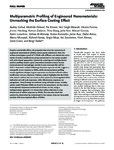Multiparametric Profiling of Engineered Nanomaterials: Unmasking the Surface Coating Effect
| dc.contributor.author | Gallud, A | |
| dc.contributor.author | Delaval, M | |
| dc.contributor.author | Kinaret, P | |
| dc.contributor.author | Marwah, VS | |
| dc.contributor.author | Fortino, V | |
| dc.contributor.author | Ytterberg, J | |
| dc.contributor.author | Zubarev, R | |
| dc.contributor.author | Skoog, T | |
| dc.contributor.author | Kere, J | |
| dc.contributor.author | Correia, M | |
| dc.contributor.author | Loeschner, K | |
| dc.contributor.author | Al‐Ahmady, Z | |
| dc.contributor.author | Kostarelos, K | |
| dc.contributor.author | Ruiz, J | |
| dc.contributor.author | Astruc, D | |
| dc.contributor.author | Monopoli, M | |
| dc.contributor.author | Handy, Richard | |
| dc.contributor.author | Moya, S | |
| dc.contributor.author | Savolainen, K | |
| dc.contributor.author | Alenius, H | |
| dc.contributor.author | Greco, D | |
| dc.contributor.author | Fadeel, B | |
| dc.date.accessioned | 2020-12-10T10:50:05Z | |
| dc.date.available | 2020-12-10T10:50:05Z | |
| dc.date.issued | 2020-11-18 | |
| dc.identifier.issn | 2198-3844 | |
| dc.identifier.issn | 2198-3844 | |
| dc.identifier.other | ARTN 2002221 | |
| dc.identifier.uri | http://hdl.handle.net/10026.1/16731 | |
| dc.description.abstract |
<jats:title>Abstract</jats:title><jats:p>Despite considerable efforts, the properties that drive the cytotoxicity of engineered nanomaterials (ENMs) remain poorly understood. Here, the authors inverstigate a panel of 31 ENMs with different core chemistries and a variety of surface modifications using conventional in vitro assays coupled with omics‐based approaches. Cytotoxicity screening and multiplex‐based cytokine profiling reveals a good concordance between primary human monocyte‐derived macrophages and the human monocyte‐like cell line THP‐1. Proteomics analysis following a low‐dose exposure of cells suggests a nonspecific stress response to ENMs, while microarray‐based profiling reveals significant changes in gene expression as a function of both surface modification and core chemistry. Pathway analysis highlights that the ENMs with cationic surfaces that are shown to elicit cytotoxicity downregulated DNA replication and cell cycle responses, while inflammatory responses are upregulated. These findings are validated using cell‐based assays. Notably, certain small, PEGylated ENMs are found to be noncytotoxic yet they induce transcriptional responses reminiscent of viruses. In sum, using a multiparametric approach, it is shown that surface chemistry is a key determinant of cellular responses to ENMs. The data also reveal that cytotoxicity, determined by conventional in vitro assays, does not necessarily correlate with transcriptional effects of ENMs.</jats:p> | |
| dc.format.extent | 2002221-2002221 | |
| dc.format.medium | Electronic-eCollection | |
| dc.language | en | |
| dc.language.iso | en | |
| dc.publisher | Wiley | |
| dc.rights | Attribution-NonCommercial-NoDerivatives 4.0 International | |
| dc.rights | Attribution-NonCommercial-NoDerivatives 4.0 International | |
| dc.rights | Attribution-NonCommercial-NoDerivatives 4.0 International | |
| dc.rights | Attribution-NonCommercial-NoDerivatives 4.0 International | |
| dc.rights | Attribution-NonCommercial-NoDerivatives 4.0 International | |
| dc.rights | Attribution-NonCommercial-NoDerivatives 4.0 International | |
| dc.rights.uri | http://creativecommons.org/licenses/by-nc-nd/4.0/ | |
| dc.rights.uri | http://creativecommons.org/licenses/by-nc-nd/4.0/ | |
| dc.rights.uri | http://creativecommons.org/licenses/by-nc-nd/4.0/ | |
| dc.rights.uri | http://creativecommons.org/licenses/by-nc-nd/4.0/ | |
| dc.rights.uri | http://creativecommons.org/licenses/by-nc-nd/4.0/ | |
| dc.rights.uri | http://creativecommons.org/licenses/by-nc-nd/4.0/ | |
| dc.subject | immunotoxicity | |
| dc.subject | nanomaterials | |
| dc.subject | nanotoxicology | |
| dc.subject | proteomics | |
| dc.subject | transcriptomics | |
| dc.title | Multiparametric Profiling of Engineered Nanomaterials: Unmasking the Surface Coating Effect | |
| dc.type | journal-article | |
| dc.type | Journal Article | |
| plymouth.author-url | https://www.webofscience.com/api/gateway?GWVersion=2&SrcApp=PARTNER_APP&SrcAuth=LinksAMR&KeyUT=WOS:000578529300001&DestLinkType=FullRecord&DestApp=ALL_WOS&UsrCustomerID=11bb513d99f797142bcfeffcc58ea008 | |
| plymouth.issue | 22 | |
| plymouth.volume | 7 | |
| plymouth.publication-status | Published | |
| plymouth.journal | Advanced Science | |
| dc.identifier.doi | 10.1002/advs.202002221 | |
| plymouth.organisational-group | /Plymouth | |
| plymouth.organisational-group | /Plymouth/Faculty of Science and Engineering | |
| plymouth.organisational-group | /Plymouth/Faculty of Science and Engineering/School of Biological and Marine Sciences | |
| plymouth.organisational-group | /Plymouth/REF 2021 Researchers by UoA | |
| plymouth.organisational-group | /Plymouth/REF 2021 Researchers by UoA/UoA06 Agriculture, Veterinary and Food Science | |
| plymouth.organisational-group | /Plymouth/Research Groups | |
| plymouth.organisational-group | /Plymouth/Research Groups/Marine Institute | |
| plymouth.organisational-group | /Plymouth/Users by role | |
| plymouth.organisational-group | /Plymouth/Users by role/Academics | |
| dc.publisher.place | Germany | |
| dcterms.dateAccepted | 2020-08-10 | |
| dc.rights.embargodate | 2021-5-1 | |
| dc.identifier.eissn | 2198-3844 | |
| dc.rights.embargoperiod | Not known | |
| rioxxterms.versionofrecord | 10.1002/advs.202002221 | |
| rioxxterms.licenseref.uri | http://creativecommons.org/licenses/by-nc-nd/4.0/ | |
| rioxxterms.licenseref.startdate | 2020-11-18 | |
| rioxxterms.type | Journal Article/Review | |
| plymouth.funder | NANOSOLUTIONS Biological Foundation for the Safety Classification of Engineered Nanomaterials (ENM): Systems Biology Approaches to Understand::European Commission FP7 |



